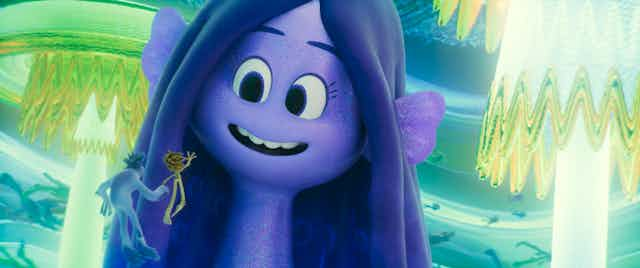Ruby Gillman’s story follows a fairly standard plot: an adolescent girl longs to go to prom but must overcome both her overprotective mother’s objections and conflict with a new popular kid at school. Oh, except the girl is actually a kraken. And her nemesis is a megalomaniac mermaid.
When you think of a kraken you probably think of a sea monster of enormous size, lashing out to sink ships that sail too close to it. It belongs to Norwegian folklore and written descriptions of the beast can be dated to the 1100s. But the new animated film writes a different narrative for this legendary creature.
The kraken has been portrayed as monstrous throughout literary and movie history. Hans Egede, a Norwegian missionary, described a kraken as covering the whole sea when it surfaced and capturing victims with its claws. Erik Pontoppidan, the Lutheran Bishop of Bergen, described it in 1753 as a giant octopus with long arms whose descent to the bottom of the ocean to feed caused a whirlpool in its wake.
His description of the kraken influenced many later literary works, including Alfred Tennyson’s famous poem, Victor Hugo’s Les Travailleurs de la mer (1866) and Jules Verne’s Twenty Thousand Leagues Under the Seas (1870).
Somewhat more recently, the film Clash of the Titans (1981) and its recent remake (2010) have brought the kraken into the universe of Greek myth, where its battle with the hero Perseus forms both films’ epic conclusion. Even though the production crew of the original film knew that the kraken was Norwegian, they decided that “as a name for a sea monster, it was too good to miss”.
In the 1981 film, the animator Ray Harryhausen’s trademark “dynamation” figure paid homage to the Creature from the Black Lagoon (1954), with a long scaly tail and four arms. The 2010 version also gave it multiple CGI tentacles, in line with the historical descriptions.
Ruby Gillman’s approach to the kraken upends these representations, showing us a softer side to the beast.
Not so scary
Rather than being a single silent behemoth living in the deep, Ruby lives on land with her family. They try to blend in with humans and explain away any peculiarities by claiming that they are originally from Canada. The Gillman family take on human appearance, colourful skin tone not withstanding, and only transform into their gigantic form when in salt water.
Krakens are usually brooding and destructive, representing the immense power of the ocean to defeat human efforts to subdue it as such monsters often do. However, Ruby’s family have a role protecting the oceans and the world from hostile forces that seek to disrupt the balance of marine power.
As well as participating in the popular trend of recuperating and reclaiming monsters like vampires and werewolves, Ruby Gillman also follows the pattern of reversing hero and villain or monster. We’ve seen this in popular films like Frozen (2013), where the handsome prince turned out to be the complete opposite of happily ever after.
In this case, the film’s antagonists turn out to be mermaids. In fairness, mermaids have never been quite as romantic as 19th-century fairy tales made them. Their roots can be traced back to the sirens of ancient Greece, who lured sailors onto rocks with their songs.
However, in Anglo-American culture, mermaids have become fantasy figures which adorn children’s clothing, accessories and toys.
The contrast with the live action remake of The Little Mermaid (2023) is striking. Rather than Ariel’s positive message of kindness, care and loyalty, Ruby Gillman’s mermaid Chelsea just wants the power of the Trident of Oceanus so she can control the seas.
By making krakens protectors and mermaids destroyers, the film continues a wider cultural trend of questioning who the monsters really are.
Beastly biology
Being a monster also taps into the film’s broader coming-of-age narrative and what it feels like to have a body that doesn’t behave as it once did.

Pixar’s Turning Red used its heroine’s transformation into a giant red panda, sometimes cute but also monstrous, as a metaphor for beginning adolescence. For Ruby, discovering her body’s true potential when she first encounters salt water leads her to question everything in her life she has previously taken for granted.
Ruby must become comfortable enough with her powers to team up with her mother and grandmother to defeat Chelsea, inviting the film’s target audience to also embrace the things which make them different to others as superpowers rather than see them as monstrous deviance.
Ruby Gillman: Teenage Kraken reinvents the mythic kraken as a guardian rather than a destroyer, presenting a fresh twist on the coming-of-age narrative by making puberty a moment to discover the strengths of your inner monster: a side of yourself you must embrace instead of fight.
The kraken might not be the first creature you would think of for exploring what it means to be in high school, but it offers a way of exploring our relationship to power and our responsibility to the natural world that feels particularly timely.

